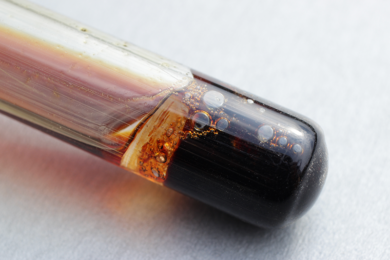 Improvements to diagnostic tools used by the mining industry will enhance the characterisation and classification of ore types and determine the best process to extract metals from each of them. This work by CSIRO has significant support of industry and focuses on chemical diagnostic leach methods to determine the complex forms and associations of gold and copper mineral deposits.
Improvements to diagnostic tools used by the mining industry will enhance the characterisation and classification of ore types and determine the best process to extract metals from each of them. This work by CSIRO has significant support of industry and focuses on chemical diagnostic leach methods to determine the complex forms and associations of gold and copper mineral deposits.
Dr Laura Kuhar, from CSIRO ‘s Minerals Down Under Flagship, says industry interest in the technology is very strong, reflecting the importance of accurate diagnostics when deciding, designing and optimising ore extraction systems. In turn, these have implications when designing plants or optimising existing extraction facilities.
This work is funded by more than 20 industry participants via the AMIRA P843A Geometallurgical Mapping and Mine Modelling (GeMIII) project. AMIRA International is an independent association of minerals companies that develops and brokers partnerships between industry and research groups around the world.
Dr Kuhar says characterisation is currently available from mineralogical tests but these rely on relatively slow and expensive technology such as quantitative X-ray diffraction and QEMSCAN analysis. “The aim of our work is to move away from these techniques to a simpler and more informative alternative, such as using a chemical solution,” she says.
Diagnostic leaching is essentially about selecting the chemical reaction and conditions that will dissolve a specific mineral so its presence in ore can be quantified and its likely processing behaviour estimated. It is a process that requires applying knowledge of the mineral’s chemistry and trying different reagents, often with an eye to optimising industrial systems or reducing environmental impacts.
This work has been underway for two years and generated considerable interest from industry partners when the researchers found that some documented diagnostic leach methods are not always as selective as claimed in the scientific literature.
This proved to be the case when the researchers looked at combining diagnostic leaches for copper and gold to make one leach that can detect and quantify the presence of both metals. “When we used these tests in the laboratory – and used mineralogical techniques to confirm the chemistry – we found that what the literature predicts should happen at different steps does not necessarily happen,” Dr Kuhar says. “The discovery of errors in the published leach methods has created interest, especially since many process plants apply the methods without mineralogical validation of their accuracy.”
In addition to devising more accurate diagnostic leach methods, Dr Kuhar’s team, which is part of the Parker CRC for Integrated Hydrometallurgical Solutions, is working on including minerals such as bornite, a copper-iron sulphide for which there is little information available in the published literature, in the diagnostic leach.
“If people want to know how much copper oxide is present in a sample, they might do an acid leach,” she says. “But bornite also dissolves to a certain extent in the acid leach and falsely increases the estimate of the ore’s copper oxide content.”
While the work on artificial mineral mixtures is ongoing, a number of P843A sponsors are providing samples for proof-of-concept validation. One of the larger projects in the pipeline is to validate the new methods on a suite of 50 samples from a particular Australian copper-gold orebody by comparing the results with those obtained using the more expensive mineralogy procedures.
“When we are happy our diagnostic leach dissolves the correct minerals in the correct stages, the sponsor will supply us with up to 500 samples,” she says. “We will then apply just the chemical diagnostic leach to provide them with information of their mineralogy.”
To date, the diagnostic leach test development within P843A has focused on copper and gold. The team is also keen to extend chemical diagnostic leaching to nickel and uranium given sufficient industry interest.
“I think the importance of the chemist is to be creative in coming up with different and novel leaches that test different reagents,” Dr Kuhar says. “Chemists have expertise regarding how a mineral will react in a certain chemical system. So I think the role of the chemist and chemistry is vital in creating diagnostic leaches that can target minerals in novel ways.”
Contact [email protected]









